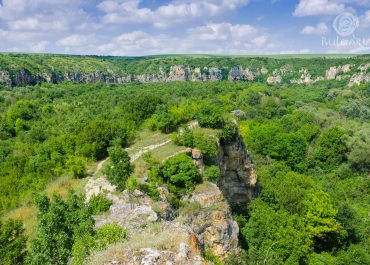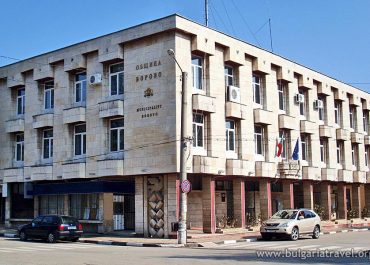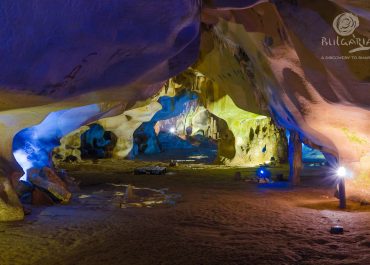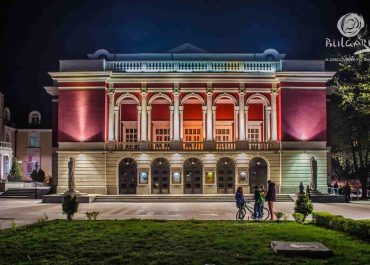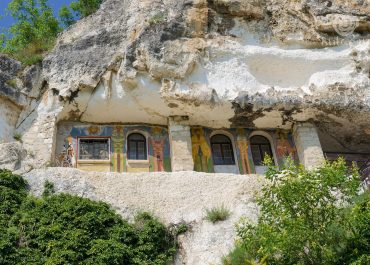
Rusenski Lom Nature Park
Rusenski Lom Nature Park is located 20 km south of Ruse and is named after Rusenski Lom River – the last right-side tributary of the Danube River. It takes up a territory of 3408 hectares and has been a protected area since 1970.
The beautiful river terraces, the high vertical rocks, the caves, the rock formations, the great biological diversity, and the historical monuments turn the park into a magnificent place of interest. Apart from the fact that Rusenski Lom Nature Park is suitable for scientific research, it also provides various opportunities for active ecotourism.
The combination of rocks, forests, rivers, and caves with meadows is the reason for the great biological diversity on the territory of the park. The flora of Rusenski Lom Park includes 902 species. The fauna consists of 10 amphibians (5 of which are protected), 19 reptiles, 22 types of fish, crayfish, snails and river mussels, and 66 mammals. The birds are among the most important inhabitants of the park: 190 species, 110 of which nest there. The conditions in the park are particularly favourable to rock-nesting birds, such as the Golden Eagle (Aquila chrysaetos), the Egyptian Vulture (Neophron percnopterus), the Long-Legged Buzzard (Buteo rufinus), the Ruddy Shelduck (Tadorna ferruginea), the Saker Falcon (Falco cherrug), etc.
There are different marked routes in the park that allow tourists to observe its biological diversity. Gramovets is a route allowing visitors to get a good look at the beautiful landscape of the rivers Lom, the great variety of plant and animal species, and the different historical sites on the territory of the park. The route starts at the Rock-Hewn Churches of Ivanovo Archaeological Reserve and continues on a beautiful trail that passes through a dense forest to reach the place where Beli Lom River and Cherni Lom River merge and give birth to Rusenski Lom River. A dirt road that leads to a cabin with a fireplace passes below impressive rocks inhabited by rare bird species. This route is approximately 12 km long.
The Dendropath is a route that familiarises tourists with the plant species in the park. The total length of the route is 6 km and it starts from Nisovo Village. The tour begins with a climb on a wide trail to a rock platform that offers a panoramic view to Malki Lom River. The route includes a level dirt road with places where fires can be lit and a small bridge over the river. Tourists can see over 20 local tree and shrub species. Information boards are in place for their convenience. In case they want to, visitors can make the route 4 km longer by going to Golyam Nisovski Monastery where they will find a recreation spot.
Another eco-trail leads to the venerable elm-tree near Nisovo Village. The 6 km-long route starts at the eastern end of the village, passes through a 17th-century Christian cemetery, climbs up the rocks, goes past the fish-ponds of the village and follows a trail to a platform located up on the rocks which offers a view to the remains of Galitsa Village. The trail climbs down to the river and reaches a recreation spot where a centuries-old European White Elm stands tall. Then it goes on to a demolished water-mill. In the period between April and October hunting bats can be watched at dusk from the bridge over Beli Lom River.
The Rock-Hewn Churches of Ivanovo – a UNESCO-protected landmark, are situated on the territory of Rusenski Lom Nature Park. A special route acquaints tourists with the history of the Rock-Hewn Churches of Ivanovo and the nature park. The starting point of the 9 km-long route is Ivanovo Village. It begins at the village railway station and continues through Ivanovo Village either along the gully near Garvalov Yalak or on the road from Ruse to the Rock-Hewn Churches of Ivanovo up Rusenski Lom River. It reaches the car park at the churches where tourists will always find a guide appointed by the Ruse Regional Museum of History.
The last route is also historically oriented – it offers a walk in and around Cherven Fortress. The starting point of this route is Cherven Village. Tourists must cross the car park at Cherven fortress and climb the stairs leading to the entrance of the stronghold. They can see nitre-excavation rock recesses. The foundations of 13 churches, a boyar’s palace, and one of the two original medieval battle towers in Bulgaria are all preserved there. There is a staircase to the river on the western side of the fortress. Tourists can also see an authentic water-supplying piece of equipment that was used in the fortress. A guide appointed by the Ruse museum is available in the fortress.
All routes are well-marked and do not require a special training. If tourists follow the marking closely, they need not to be accompanied by guides from the nature park.
Guided tours are only available upon request in advance. Hunting is prohibited on the territory of the nature park, as well as lighting fires outside the spots that are specially designed for the purpose.
Information materials and souvenirs are sold at the stores in the towns and the villages located on the territory of the park.
Rusenski Lom Nature Park Directorate
Monday – Friday
8:30 – 12:00, 12:30 – 17:00
There are several ways to get to Rusenski Lom Nature Park:
Take the Sofia – Ruse main road and make a right turn at the junction to Ivanovo Village. Then follow the signposts to the park;
Start from Ruse and head for Ivanovo Village. You can take the road that passes through Basrabovo Village and get to the northern-most point of the park;
Take the junction to Svalyane Village at Pisanets Village on the Varna – Ruse road. Svalyane Village is the southern-most point of the park;
Take the junction to Ivanovo Village at Dve mogili Village on the Sofia – Ruse road. You will reach Orlova chuka Cave and Cherven.
Experts appointed by the park administration who speak English, German, and Russian provide services to tourists.
Tourist Information Center – Ruse
Monday – Friday
09:00 – 18:00
Saturday
09:30 – 18:00
7000 Ruse Center, 61 Aleksandrovska Str
Tel: +359 82 824 704
Email: office@visitruse.info
Website: http://www.visitruse.info/
Rusenski Lom Nature Park Directorate
Ruse 7000, 7 Skobelev Blvd.
Tel: +359 82 872 397
Website:https://rusenski-lom.bg/
Е-mail:
dpprusenskilom@gmail.com
dpprusenski_lom@iag.bg
Rusenski Lom Nature Park is located 20 km south of Ruse and is named after Rusenski Lom River – the last right-side tributary of the Danube River. It takes up a territory of 3408 hectares and has been a protected area since 1970.
The beautiful river terraces, the high vertical rocks, the caves, the rock formations, the great biological diversity, and the historical monuments turn the park into a magnificent place of interest. Apart from the fact that Rusenski Lom Nature Park is suitable for scientific research, it also provides various opportunities for active ecotourism.
The combination of rocks, forests, rivers, and caves with meadows is the reason for the great biological diversity on the territory of the park. The flora of Rusenski Lom Park includes 902 species. The fauna consists of 10 amphibians (5 of which are protected), 19 reptiles, 22 types of fish, crayfish, snails and river mussels, and 66 mammals. The birds are among the most important inhabitants of the park: 190 species, 110 of which nest there. The conditions in the park are particularly favourable to rock-nesting birds, such as the Golden Eagle (Aquila chrysaetos), the Egyptian Vulture (Neophron percnopterus), the Long-Legged Buzzard (Buteo rufinus), the Ruddy Shelduck (Tadorna ferruginea), the Saker Falcon (Falco cherrug), etc.
There are different marked routes in the park that allow tourists to observe its biological diversity. Gramovets is a route allowing visitors to get a good look at the beautiful landscape of the rivers Lom, the great variety of plant and animal species, and the different historical sites on the territory of the park. The route starts at the Rock-Hewn Churches of Ivanovo Archaeological Reserve and continues on a beautiful trail that passes through a dense forest to reach the place where Beli Lom River and Cherni Lom River merge and give birth to Rusenski Lom River. A dirt road that leads to a cabin with a fireplace passes below impressive rocks inhabited by rare bird species. This route is approximately 12 km long.
The Dendropath is a route that familiarises tourists with the plant species in the park. The total length of the route is 6 km and it starts from Nisovo Village. The tour begins with a climb on a wide trail to a rock platform that offers a panoramic view to Malki Lom River. The route includes a level dirt road with places where fires can be lit and a small bridge over the river. Tourists can see over 20 local tree and shrub species. Information boards are in place for their convenience. In case they want to, visitors can make the route 4 km longer by going to Golyam Nisovski Monastery where they will find a recreation spot.
Another eco-trail leads to the venerable elm-tree near Nisovo Village. The 6 km-long route starts at the eastern end of the village, passes through a 17th-century Christian cemetery, climbs up the rocks, goes past the fish-ponds of the village and follows a trail to a platform located up on the rocks which offers a view to the remains of Galitsa Village. The trail climbs down to the river and reaches a recreation spot where a centuries-old European White Elm stands tall. Then it goes on to a demolished water-mill. In the period between April and October hunting bats can be watched at dusk from the bridge over Beli Lom River.
The Rock-Hewn Churches of Ivanovo – a UNESCO-protected landmark, are situated on the territory of Rusenski Lom Nature Park. A special route acquaints tourists with the history of the Rock-Hewn Churches of Ivanovo and the nature park. The starting point of the 9 km-long route is Ivanovo Village. It begins at the village railway station and continues through Ivanovo Village either along the gully near Garvalov Yalak or on the road from Ruse to the Rock-Hewn Churches of Ivanovo up Rusenski Lom River. It reaches the car park at the churches where tourists will always find a guide appointed by the Ruse Regional Museum of History.
The last route is also historically oriented – it offers a walk in and around Cherven Fortress. The starting point of this route is Cherven Village. Tourists must cross the car park at Cherven fortress and climb the stairs leading to the entrance of the stronghold. They can see nitre-excavation rock recesses. The foundations of 13 churches, a boyar’s palace, and one of the two original medieval battle towers in Bulgaria are all preserved there. There is a staircase to the river on the western side of the fortress. Tourists can also see an authentic water-supplying piece of equipment that was used in the fortress. A guide appointed by the Ruse museum is available in the fortress.
All routes are well-marked and do not require a special training. If tourists follow the marking closely, they need not to be accompanied by guides from the nature park.
Guided tours are only available upon request in advance. Hunting is prohibited on the territory of the nature park, as well as lighting fires outside the spots that are specially designed for the purpose.
Information materials and souvenirs are sold at the stores in the towns and the villages located on the territory of the park.
Rusenski Lom Nature Park Directorate
Monday – Friday
8:30 – 12:00, 12:30 – 17:00
There are several ways to get to Rusenski Lom Nature Park:
Take the Sofia – Ruse main road and make a right turn at the junction to Ivanovo Village. Then follow the signposts to the park;
Start from Ruse and head for Ivanovo Village. You can take the road that passes through Basrabovo Village and get to the northern-most point of the park;
Take the junction to Svalyane Village at Pisanets Village on the Varna – Ruse road. Svalyane Village is the southern-most point of the park;
Take the junction to Ivanovo Village at Dve mogili Village on the Sofia – Ruse road. You will reach Orlova chuka Cave and Cherven.
Experts appointed by the park administration who speak English, German, and Russian provide services to tourists.
Tourist Information Center – Ruse
Monday – Friday
09:00 – 18:00
Saturday
09:30 – 18:00
7000 Ruse Center, 61 Aleksandrovska Str
Tel: +359 82 824 704
Email: office@visitruse.info
Website: http://www.visitruse.info/
Rusenski Lom Nature Park Directorate
Ruse 7000, 7 Skobelev Blvd.
Tel: +359 82 872 397
Website:https://rusenski-lom.bg/
Е-mail:
dpprusenskilom@gmail.com
dpprusenski_lom@iag.bg
Virtual map
Photos
© All images, advertising and video materials and/or other information published on this website are property of the Ministry of Tourism and are protected by the Law on Copyright and Related Rights, according to the Bulgarian laws to all applicable international and relevant acts of the European Union.


